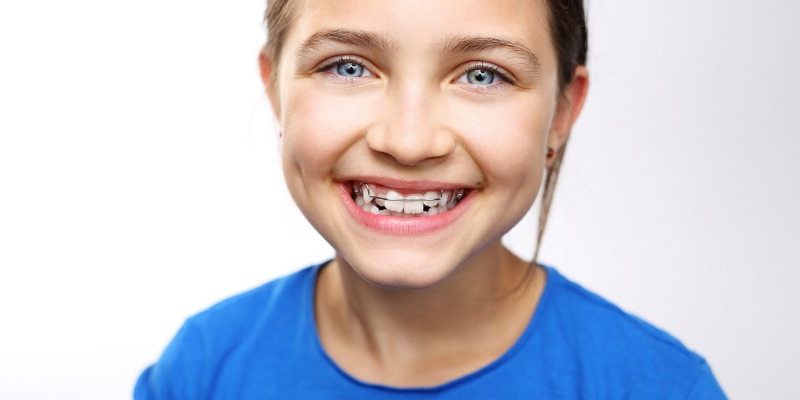 Typically, most children who need braces start treatment between the ages of 10 to 14. There are situations where a child may need treatment before this, which is known as early orthodontic treatment.
Typically, most children who need braces start treatment between the ages of 10 to 14. There are situations where a child may need treatment before this, which is known as early orthodontic treatment.
If a child needs treatment at a younger age, it’s often preventative. Orthodontists can intercept some problems and solve some issues quicker and easier when the patient is a child rather than waiting until they’re a teenager. Wearing a retainer as a child may not replace the need for braces later on, but it will make the braces treatment faster and more effective.
Preventative treatment can also help avoid major problems later on. Simple preventative measures can stop tooth loss and overcrowding.
How do I Know if My Child Needs Early Orthodontic Treatment?
There are several reasons for children requiring early orthodontic treatment. The most common are:
Protruding upper teeth
Top teeth that protrude past the bottom teeth come with several risks. Firstly, protruding teeth are at greater risk of being chipped or knocked out in an accident in kids who are accident prone. Some children are teased by other children which can lead to loss of self esteem and other psychological problems and those kids can benefit from reducing the protrusion early.

Crossbite
Early diagnosis and treatment of a crossbite is important because major problems can occur if we delay treatment. The temporomandibular joint (TMJ) connects your jawbone to your skull and a crossbite can increase the risk of TMJ disorders. The disorder can cause jaw pain or tenderness, difficulty chewing, aching facial and ear pain or locking of the jaw. A crossbite can also cause uneven wearing of the teeth.
A crossbite can be improved or repaired with early orthodontic treatment so it doesn’t cause future problems. Usually a crossbite is caused by a narrow upper jaw. This narrowness may result in the developing teeth being crowded so expanding the jaw with a device can address the bite problem and make room for developing teeth.
Impacted Teeth
An impacted tooth may not cause any pain but it can place pressure or rub on the surrounding teeth which can lead to the loss of a tooth. An impacted tooth can also cause gum problems or infection and may merge in a really abnormal position.
Many patients don’t realise they have an impacted tooth until they have an x-ray at the dentist or orthodontist. Others realise there may be a problem because a baby tooth hasn’t fallen out, an adult tooth has failed to erupt or only partially erupted. An impacted tooth may not cause any pain but it can place pressure or rub on the surrounding teeth.
In some problems, with early intervention, such as extracting the preceding baby tooth or expansion of a narrow jaw, impacted teeth may be encouraged to move into a normal position. Occasionally impacted teeth will need to be uncovered by a gum specialist and braces can pull the impacted tooth into place without it damaging the surrounding teeth.
Unattractive Teeth
In today’s culture appearance matters, unfortunately. It matters to children, teens and adults. For some children they dislike their teeth so much they ask their parents for braces at a very young age to improve the look. Often their self-esteem improves with their straightening teeth.
Psychological Issues
Many children and adults today suffer from body image issues. Sometimes their expectation of looking like someone famous they follow on social media is unrealistic. While it may seem like harmless vanity, there is a dark side to the way young people judge their appearance. Their self-esteem can be irreparably damaged and it can be the start of mental health problems that continue into adulthood.
Children can be cruel and a friend or bully’s comments about a child’s less than perfect teeth can be damaging. The hurtful comments can contribute to the start of depression and anxiety in children. More parents than ever are using orthodontics to correct their child‘s cosmetic teeth problems because they fear their peers will tease them.
At What Age Should your Child See An Orthodontist?
If you suspect your child needs orthodontic treatment, it’s ideal to see an orthodontist when they are between the ages of seven and nine. Even if the child only has their molars through, an orthodontist can check on the growth of the jaw and palate and loss of baby teeth. Some problems are clear at this age while other children need to wait until most of their adult teeth are in before it’s known whether or not they need braces.
In about half of all cases of children seen at this age, early intervention orthodontic treatment is recommended. Treatment may not start straight away but it gives parents information about the options available.
Some patients will visit the orthodontist annually to check on their adult teeth eruptions until it is time for early intervention or braces.

Early Vs Late Orthodontic Treatment
There is no right or wrong time to have orthodontic treatment. More than ever adults are coming in for braces. There are pros and cons for treating earlier in life and later.
Benefits of Early Orthodontic Treatment
Treating children before their palate and jaw have stopped growing has major benefits. If overcrowding is (or will be) an issue, an orthodontist can use an expander plate to increase the size of the jaw (and smile) to make enough room for the teeth. Once the palate fuses, this option disappears and major jaw problems can only be corrected with surgery or teeth removed before braces to fix an over crowding problem.
Having orthodontic treatment as children or teens is ideal because that’s when their peers are. Towards the end of high school, a teenager may decide against treatment. They feel like they have ‘missed the boat’ because their friends have finished treatment or the school ball is coming up. Later in life they may wish they went ahead with braces but at the time it didn’t seem important with everything else going on.
As parents it can be easier to encourage a younger child to have braces but not so much a head-strong teenager!
Orthodontic Treatment Later in Life
As we age our perceptions change. As a teenager 20 or 30 years ago we may not have worried about our appearance. But as adults we might dislike the look of our teeth and want to do something about them.
Orthodontic treatment decades ago was quite different to what it is today with development of many aesthetically improved devices. The orthodontic industry’s knowledge has improved greatly during this time and we can achieve far better results today.
We’ve seen plenty of adults who had braces many years ago complain that their teeth moved after treatment because there wasn’t the option of a permanent retainer or they didn’t wear their removable retainer long enough.
Some patients have sought treatment as adults because their parents couldn’t afford it all those years ago when they were teenagers. As adults they can afford to pay for their own treatment and may have health insurance to help with the cost.
Adults also have the benefit of different orthodontic treatment options. Years ago the only treatment available was metal braces. Now they may choose between Invisalign, lingual (inside) braces or ceramic braces which are often more appealing to an adult. The concealed braces and Invisalign are more expensive than standard metal braces so adults are more likely to afford an aesthetic option.
Adults are more compliant than teenagers. They will brush their teeth more often and follow their orthodontists instructions more readily so removable Invisalign retainers are a safer option for them.
While adults don’t have the benefit of using their growing mouth and jaw to help with orthodontic treatment, the final result is still impressive. Treatment may take slightly longer if they opt for a concealed option but their new smile rewards their patience for the rest of their lives.
Whatever age you bring your child in for an appointment, you can be rest assured it will be obligation-free. We’ll give you our professional opinion and leave it up to you to decide when your child should start orthodontic treatment. You can make an appointment at The Orthodontists by calling (08) 9364 8020 or booking an appointment online.